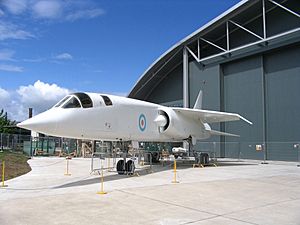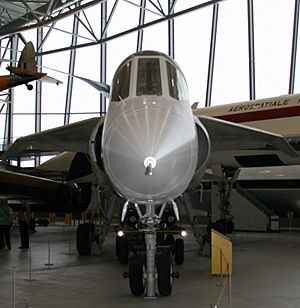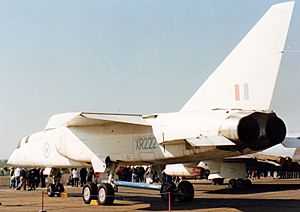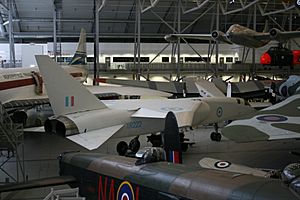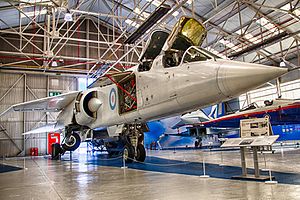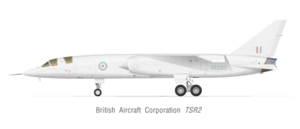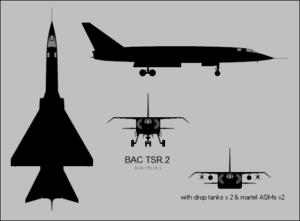BAC TSR-2 facts for kids
class="infobox " style="float: right; clear: right; width: 315px; border-spacing: 2px; text-align: left; font-size: 90%;" ! colspan="2" style="text-align: center; font-size: large; padding-bottom: 0.3em;" | TSR-2 |-
|- | colspan="2" style="text-align: center;" |  |- |colspan="2" style="border-bottom: 1px solid #aaa;text-align:center;" |The only TSR-2 to fly, XR219 in anti-flash white finish, at BAC's Warton factory in 1966 |-
|- |colspan="2" style="border-bottom: 1px solid #aaa;text-align:center;" |The only TSR-2 to fly, XR219 in anti-flash white finish, at BAC's Warton factory in 1966 |-
! Role | Strike/reconnaissance |- ! National origin | United Kingdom |- ! Manufacturer | British Aircraft Corporation |-
! First flight | 27 September 1964 |-
! Status | Cancelled |-
! Number built | 3 |-
|}
The British Aircraft Corporation TSR-2 was a special airplane designed for the Royal Air Force (RAF) in the UK during the Cold War. It was meant to be a "strike" aircraft, meaning it could attack targets, and a "reconnaissance" aircraft, which means it could fly over areas to gather information.
The TSR-2 was designed to fly very fast and very low to the ground, even in enemy territory. It could carry both regular bombs and nuclear weapons. It was also supposed to gather information using special radars and cameras. However, only one TSR-2 ever flew. Test flights showed it was getting too heavy and might not meet all its original goals.
The TSR-2 project faced many problems. Its costs kept going up, and there were disagreements within the British government about what kind of planes the country needed. In 1965, the government made a tough decision to cancel the project. They first thought about buying the American General Dynamics F-111 Aardvark instead, but that plan was also dropped because of rising costs. In the end, the RAF used other planes like the Blackburn Buccaneer and McDonnell Douglas F-4 Phantom II. Much later, a smaller plane called the Panavia Tornado was developed by several European countries to do similar jobs.
Contents
Developing a New Plane
Changing Needs in the Sky
After World War II, new jet engines changed how planes were designed. The British wanted a jet-powered plane to replace their successful de Havilland Mosquito bomber. The Mosquito was very fast because it didn't have any defensive guns, making it hard to shoot down.
This led to the English Electric Canberra, another fast jet bomber without defensive weapons. The Canberra could fly very high, above where most enemy fighter jets could reach. This made it great for bombing and spying missions. It was so good that even the United States built their own versions of it.
But by the late 1950s, things changed. The Soviet Union developed new surface-to-air missiles (SAMs). These missiles could fly much higher and faster than any plane. This made high-flying planes like the Canberra and larger bombers very vulnerable. The first plane shot down by a Soviet SAM was an American spy version of the Canberra in 1959.
So, the solution was to fly lower. Radar systems can't see very far over the horizon or through hills and trees. This meant planes flying very low could stay hidden from enemy radar. This led to a new type of plane called a "low-level strike aircraft." These planes needed strong wings to handle bumpy air close to the ground, special navigation radars to fly fast and low, and lots of fuel because flying low uses more gas.
The Big Plan: GOR.339
In 1955, the British government started working with a company called English Electric to design a new bomber to replace the Canberra. They wanted a plane that could fly far, reach speeds of Mach 1.5 (1.5 times the speed of sound) at high altitude, and fly low for 600 miles. It needed two crew members and could carry four 1,000-pound bombs.
These ideas became an official plan in November 1956, called General Operational Requirement 339 (GOR.339). This was a very ambitious plan for the time. It asked for a supersonic plane that could fly in any weather, day or night, deliver nuclear weapons far away, fly at Mach 2 (twice the speed of sound) at high altitude or Mach 1.2 at low altitude. It also needed to take off and land in very short distances, even from rough fields, because it was thought that runways might be destroyed in a war.
Specifically, the plane needed to:
- Deliver nuclear weapons at low altitude, day or night, in any weather.
- Take photos for spying at medium and low altitudes, day and night.
- Gather electronic information in any weather.
- Deliver nuclear weapons at medium altitudes, even if the pilot couldn't see the target.
- Carry regular bombs and rockets.
It was supposed to fly as low as 200 feet above the ground at Mach 1.1. Its range would allow it to be used for both short-range (tactical) and long-range (strategic) missions.
Political Challenges
As companies studied this plan, political problems began. In 1957, the Defence Minister, Duncan Sandys, said that manned combat planes were old news and that ballistic missiles were the future. This caused a big debate. Senior RAF officers argued that planes were still important because they could move around, and the TSR-2 could replace not only the Canberra but also the larger "V bombers."
Another political issue was that the government wanted aircraft companies to work together or merge. There were too many companies and not enough orders. So, the government pushed for companies to combine.
Also, different parts of the military didn't always trust each other. The Royal Navy was developing its own low-flying attack plane, the Blackburn Buccaneer, for use over water. Some people thought the RAF should just use a version of the Buccaneer to save money. Lord Mountbatten, a high-ranking military leader, strongly supported the Buccaneer, saying five Buccaneers could be bought for the price of one TSR-2. But the RAF refused, saying the Buccaneer wasn't good enough for their needs.
Another person against the TSR-2 was Sir Solly Zuckerman, a scientific advisor. He didn't think British technology was good enough and preferred buying military equipment from the United States.
Choosing a Design
Many companies submitted designs for GOR.339 by January 1958. English Electric and Vickers-Armstrongs were chosen for further review. Vickers impressed the government with its complete plan, including all the electronics and support needed. English Electric's design was also good, especially its wing. So, the government decided to combine the best parts of both. Vickers would build the front half of the plane, and English Electric would build the back.
In January 1959, the government officially announced that the TSR-2 would be built by Vickers-Armstrongs and English Electric working together. The name "TSR-2" stood for "Tactical Strike and Reconnaissance, Mach 2." The "Strike" part meant it could carry nuclear weapons.
On January 1, 1959, the project officially began. In February, it was renamed Operational Requirement 343 (OR.343). This new plan was even more specific, saying the plane should fly at 200 feet or less and reach Mach 2 at high altitude.
What the TSR-2 Would Do
The main job for the TSR-2 was to carry a 2,000-pound weapon inside its body. It was supposed to fly 1,000 miles to its target and back. For part of this journey (100 miles), it would fly at high altitude at Mach 1.7. For the most dangerous part (200 miles into and out of the target area), it would fly as low as 200 feet at Mach 0.95. The rest of the flight would be at Mach 0.92. If it had to fly the entire mission at 200 feet, its range would be shorter, about 700 miles. It could carry heavier weapons, but this would also reduce its range.
To fly even further, the TSR-2 could carry extra fuel tanks under its wings or under its body. If it didn't carry internal weapons, it could even put a fuel tank in its bomb bay. Later versions might have had wings that could change shape during flight.
The TSR-2 was also planned to have a special spy kit in its weapons bay. This included cameras and a sideways-looking radar (SLR) to gather information. The linescan unit would use daylight or artificial light for night reconnaissance.
Nuclear Weapons for the TSR-2
The TSR-2 was initially planned to carry the existing Red Beard nuclear bomb. But this bomb wasn't good for supersonic flight and its power (15 kt) was considered too small. So, in 1959, a new, more powerful bomb was designed for the TSR-2, called OR.1177. This bomb was supposed to have yields of 50, 100, 200, or 300 kt.
However, in 1962, a government rule limited all future tactical nuclear weapons to 10 kt. The RAF had to change its plans, but they made sure the bomb could be upgraded later. To make up for the lower power, they thought about dropping several smaller bombs (called WE.177A) in a row, like a "stick bombing" attack. This meant the TSR-2 needed to carry four WE.177As, two inside and two under its wings. The bomb bay was originally designed for one Red Beard, so the WE.177A had to be made narrower to fit two side-by-side.
Carrying nuclear bombs under the wings had a problem: the bombs would get too hot at high speeds. The WE.177A could only be carried for five minutes at Mach 1.15 at low level on the TSR-2, which was a big limitation for a plane designed for fast, low-level flight.
Later, the idea of dropping multiple small nuclear bombs was dropped as larger bombs became an option again. The TSR-2 was also considered for carrying nuclear stand-off missiles, but this didn't happen. Instead, it was planned to carry conventional missiles like the French AS-30 and later the British AJ-168 Martel.
After the TSR-2 was cancelled, the RAF used American F-4 Phantom IIs for tactical nuclear strikes. The WE.177A bomb was eventually delivered to the RAF in 1971 for use on Buccaneer planes. By 1975, the RAF had a more powerful WE.177C bomb, similar to what they originally wanted for the TSR-2 in 1959.
How the TSR-2 Was Designed
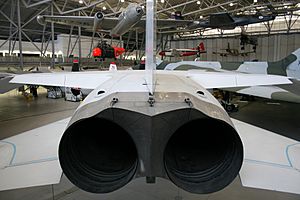
In 1959, English Electric (EE) and Vickers worked together to combine the best parts of their designs. EE had a good delta wing design, and Vickers had a good long body (fuselage). So, they decided to use EE's wing and Vickers' fuselage. The two companies also merged to form the British Aircraft Corporation (BAC).
The TSR-2 was powered by two Bristol-Siddeley Olympus jet engines with reheaters (which give extra thrust). These engines were later developed for the supersonic Concorde passenger jet. The TSR-2 had small, shoulder-mounted delta wings with tips that pointed down. It also had a moving tail and a large moving fin at the back. It had special "blown flaps" on the wings to help it take off and land in short distances. It didn't have ailerons (flaps on the wings that help with rolling); instead, it used its tail to control rolling. The wings were designed to be very strong, which helped the plane fly smoothly at high speeds and low altitudes, even in bumpy air. The chief test pilot, Roland Beamont, said the TSR-2 was very easy to fly at supersonic speeds.
The TSR-2 could fly at Mach 2.05 (more than twice the speed of sound) at high altitudes and could even reach Mach 2.35 for short bursts. Its theoretical top speed was Mach 3.
The plane had very advanced avionics (electronic systems) for navigation and attacking targets. These systems were so complex that they were a big reason for the project's rising costs. Features like forward-looking radar and side-looking radar for navigation were very new at the time and only became common on military planes years later. These systems allowed for an advanced autopilot that could fly the plane very low to the ground, following the terrain, which made the pilot's job much easier.
Building the TSR-2 had many problems. Some parts were made by different companies, which caused communication issues and more cost increases. The project was the largest aircraft project in Britain's history.
Instead of building prototypes (early test versions), they decided to build a "development batch" of nine planes using production tools. This meant the first planes had to meet strict production standards, which caused delays. In the end, the first few planes acted like prototypes anyway, with many changes from the final design.
Flight Tests and Cancellation
Testing the Plane
Despite the rising costs, the first two development planes were finished. Problems with the engines and landing gear caused delays. The TSR-2 missed its chance to be shown to the public at the 1964 Farnborough Airshow. Before testing, a politician named Denis Healey criticized the plane, saying it would be too expensive and easily shot down by new missiles.
Test pilot Roland Beamont made the first flight on September 27, 1964. The first few flights were done with the landing gear down and limited speed. On the second flight, a fuel pump caused vibrations that made the pilot's vision blurry for a moment.
It took 10 test flights before the landing gear could be retracted successfully. Even then, there were serious vibration problems when landing. The first supersonic flight happened on the 14th test flight. The plane reached Mach 1 (the speed of sound) using only its main engine power, without the reheater. When the pilot used one reheater, the TSR-2 sped away from a chase plane, an English Electric Lightning, which was a very fast interceptor itself. Another test pilot, Jimmy Dell, said the TSR-2 handled "like a big Lightning."
Over six months, 24 test flights were done. Most of the complex electronics weren't in the first plane, so these flights focused on how the plane flew. Test pilots said it flew wonderfully. It reached Mach 1.12 and flew as low as 200 feet over the Pennines mountains. The landing gear vibrations continued, but they improved in the last few flights when extra supports were added. The last test flight was on March 31, 1965.
Even though the testing wasn't finished, the TSR-2's basic design was considered very good and a big step forward. However, costs kept rising, and the plane wasn't meeting all its original requirements, like takeoff distance and combat range. To save money, a simpler version was agreed upon, with a shorter combat range (650 miles), a lower top speed (Mach 1.75), and a longer takeoff distance.
The Project Is Cancelled
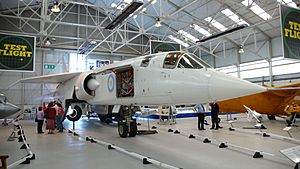
By the 1960s, the United States was developing its own swing-wing plane, the General Dynamics F-111 Aardvark. Australia had shown some interest in the TSR-2, but in 1963, they chose the F-111 instead because it was offered at a better price and delivery time. However, Australia had to wait 10 years for the F-111 to be ready, and its cost tripled. The RAF was also asked to consider the F-111 as a cheaper option.
Despite protests from BAC employees, the new Labour government, which came to power in 1964, decided to cancel the TSR-2. This decision was made on April 1, 1965, because of the high projected costs. They decided to get an option to buy up to 110 F-111s instead. The cancellation was announced on April 6, 1965. The second TSR-2 plane, XR220, was supposed to have its first flight that day, but it never happened. Only the first prototype, XR219, ever flew.
All the TSR-2 planes were ordered to be destroyed and burned.
A famous aircraft designer, Sydney Camm, once said about the TSR-2: "All modern aircraft have four dimensions: span, length, height and politics. TSR-2 simply got the first three right." This meant the plane was technically excellent, but politics caused its downfall.
What Replaced the TSR-2
To replace the TSR-2, the Air Ministry first considered the General Dynamics F-111K (a special version of the F-111). They also looked at a version of the French Dassault Mirage IV and an improved Blackburn Buccaneer. None of these were chosen right away.
In 1966, the Air Ministry decided on two planes: the F-111K and a joint British-French project for a variable geometry (swing-wing) attack plane called the AFVG. Defence Minister Healey claimed the TSR-2 would have cost £1,700 million over 15 years, compared to £1,000 million for the F-111K/AFVG combination. Although 50 F-111Ks were ordered for the RAF, the F-111 program also faced huge cost increases and technical problems. The order for the F-111Ks was eventually cancelled in January 1968.
In the end, the RAF used a combination of the McDonnell F-4 Phantom II and the Blackburn Buccaneer. Some Buccaneers were even transferred from the Royal Navy. These were the same planes the RAF had rejected earlier to get the TSR-2! However, the Buccaneer proved to be a very capable plane and stayed in service until 1994. The Phantoms also served until 1992.
In the 1970s, the SEPECAT Jaguar replaced the Phantoms in the attack and reconnaissance roles. In the 1980s, both the Jaguar and Buccaneer were replaced by the Panavia Tornado, which was a much smaller swing-wing plane. The lessons learned from designing the TSR-2's advanced electronics, especially its terrain-following system, were used in the Tornado program. In the late 1970s, there was a small attempt to bring back the TSR-2 project, but it didn't go anywhere.
Surviving Planes
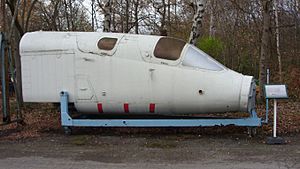
Most of the TSR-2 parts and unfinished planes were destroyed very quickly after the cancellation. However, two planes survived:
- XR220 is on display at the RAF Museum, Cosford.
- XR222 is on display at the Imperial War Museum Duxford.
- A cockpit section is on display at Brooklands Museum.
- Two Bristol Siddeley Olympus 22R-320 engines are on display at Gatwick Aviation Museum.
The only TSR-2 that ever flew, XR219, along with XR221 and XR223, were taken to Shoeburyness and used as targets to test how well modern planes could withstand gunfire and explosions. The quick destruction of the project has been a source of much debate and sadness, similar to the cancellation of the American Northrop Flying Wing bombers and the Canadian Avro Canada CF-105 Arrow interceptor.
Specifications
Data from TSR2: Britain's Lost Bomber
General characteristics
- Crew: 2
- Length: 89 ft (27 m)
- Wingspan: 37 ft 2 in (11.33 m)
- Height: 23 ft 9 in (7.24 m)
- Wing area: 702.9 sq ft (65.30 m2)
- Empty weight: 54,750 lb (24,834 kg)
- Gross weight: 79,573 lb (36,094 kg)
- Max takeoff weight: 103,500 lb (46,947 kg)
- Powerplant: 2 × Bristol Siddeley B.Ol.22R Olympus Mk.320 afterburning turbojet engines, 22,000 lbf (98 kN) thrust each dry, 30,610 lbf (136.2 kN) with afterburner
Performance
- Maximum speed: Mach 2.15 at 40,000 ft (12,192 m), M1.1 at sea level
- Range: 2,500 nmi (2,877 mi; 4,630 km)
- Combat range: 750 nmi (863 mi; 1,389 km)
- Service ceiling: 40,000 ft (12,000 m)
- Rate of climb: 15,000 ft/min (76 m/s)
- Thrust/weight: 0.59
Armament
Total weapons load of 10,000 lb (4,500 kg); 6,000 lb (2,700 kg) internal and 4,000 lb (1,800 kg) external
- Internal weapons bay, 20 ft (6 m) long, with (initially) 1 Red Beard 15 kt nuclear weapon or as intended 2 × OR.1177 300 kt nuclear weapons or 6 × 1,000 lb (450 kg) HE bombs. Final designed normal load in nuclear role of up to 4 × WE.177 nuclear weapons, two side-by-side or in tandem in weapons bay, two on external underwing stores pylons.
Avionics
- Autonetics Verdan autopilot modified by Elliot Automation
- Ferranti (terrain-following radar and navigation/attack systems)
- EMI (Side looking airborne radar)
- Marconi (general avionics)
- Cossor (IFF)
- Plessey (Radio)
See also
 In Spanish: British Aircraft Corporation TSR-2 para niños
In Spanish: British Aircraft Corporation TSR-2 para niños
- Similar aircraft
- Dassault Mirage IV
- General Dynamics F-111 Aardvark
- North American A-5 Vigilante
- Sukhoi Su-24
- Lists related to this aircraft
- List of bomber aircraft


